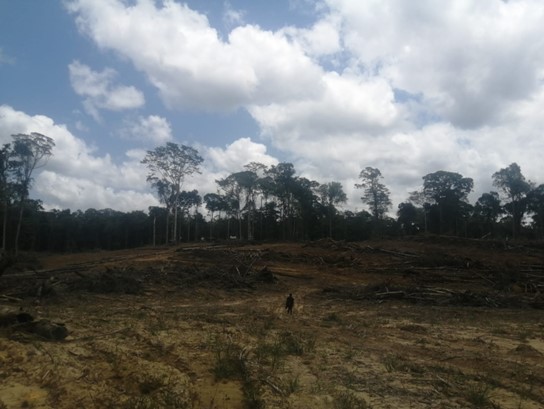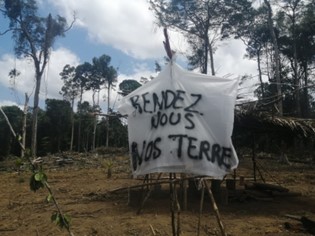
By Karlijn Korpershoek
Disclaimer: In this blog post, it is not possible to go over all the complexities and entanglements of the CEOG site in Guyane. Rather, this is the first part of a series in which I will try to unravel the story, find linkages to the rest of my research and explore how the fight for Amerindian voices is largely ignored in continental Europe.
It is March 10, very early morning, and together with a girl I met through the Signal group of Extinction Rebellion Guyane, we are driving towards Prosperité. We have answered the call for a mobilisation, or demonstration, against the deforestation close to the Amerindian village of Prosperité that was advertised through the XR groups and on Facebook.
There has been ongoing tension for over three years now, which has particularly spiked in the past months, regarding a large-scale energy project: Centre Electricity de L’Ouest Guyanais (CEOG in short, centre for electricity for the West of Guyane). CEOG is a project where a photovoltaic plant and a mass storage of energy in the form of hydrogen are combined. The plant will supply the west of Guyane with energy, as the region is suffering from an energy deficit. In order to make place for the plant, close to 80 hectares of forest will be cleared, with an additional 60 hectares being part of the lease agreement between CEOG and ONF (l’Office national des forêts) (Zralos, 2022). The proponents of the project emphasise that it is innovative, clean and reliable.
However, the plant is placed very close to the Amerindian village of Prosperité, inhabited primarily by Kali’na, one of the six Indigenous groups of Guyane. They vehemently oppose the placement of the project, as the site is only a few hundred metres removed from their houses, and the deforestation is directly interfering with their living, hunting and fishing spaces. For them, the part of the forest is integrated into their lives and should be left as is.
What is important to immediately emphasise is that the protests and arguments of most of the people of Prosperité are not about the plant itself; they recognize the need for electricity supply and they do not want to impede the livelihoods of others. They are primarily arguing against the location and would not object against the project being placed elsewhere, which they mentioned in the media beforehand (Socios Engages, 2022) as well as during the protests themselves.
So the protests on the 10th were really about who has the right to make decisions and stake a claim about land in Guyane. When we arrive around 11am in the morning on the section of the main road that borders the village and the CEOG site, the ambiance is clearly tense: gendarmerie, military police, are abundant and a large military truck is parked on the right side of the road. As we near the barricade, a fear starts creeping in: is it a good idea to get involved in a situation that is obviously threatening, with no preparation and limited knowledge of the exact situation? An officer approaches us and asks if we want to pass. When we answer that we want to join the demonstration, his demeanour changes and
obviously seems to think that it is not a very good idea: “go ahead, you can try” he says as he gestures us on.
At this point, neither of us feels very secure, but we continue and park our car just behind the group of demonstrators. Even though the atmosphere is tense, the situation seems to be relatively calm when we step out of the car. There are small groups of people scattered along the road, with a larger group demonstratively standing in front of the line of gendarmerie who are occupying the width of the road.
I start chatting with some people living in the village closeby, who told me that earlier that morning, the protests had started at 6.30am, the gendarmerie had been using tear gas but that it had calmed down since then. Five arrests had been made. I join the protesters, speaking to some of them about their experiences of the morning and past protests, as this is the 6th time that something like this has been organised. Someone remarks that today was especially violent. Someone else tell me that they have been very fearful, particularly as there is a sustained military and police presence in the region.
An hour after I arrived, the gendarmerie announces they are leaving. Some of them step on their quads, others jump onto the large truck that has been parked on the road all this time. They leave under a loud cheer from the crowd; one man sarcastically blows kisses their way as they pass by on their way out.
Afterwards, a little unclear about what comes next and not getting a clear answer from anyone, we stand around a little bit. But then the chief of the village, Yopoto Roland Sjabere, starts giving a speech. It is clear that this is not the last time a demonstration will be organised. “Next time, we will go into the forest. Where the ambiance will be … different”. I am not sure what “different” means (More violent? Easier? Complicated? Tense?), but I make a note to make sure to be there.
We wait to see what happens next. Many people who came to protest but are not living in the village, leave with a last claxon of support. I am waiting to see if people are going into the forest, to the village or somewhere else. After a few minutes, the Chief arrives in a car and someone gestures to me and my friend to go with him so he can show us the site of the deforestation. We jump into the car, with another protester, and take off into the forest. Not sure what to expect, it is an impressive sight to drive onto a stretch of, what used to be, forest and was now just barren land. This is the initial 16 hectares that represent the start of the project, but is only a small portion of what the space that the site will eventually occupy. A small hut, where a few fellow protesters are sitting on a bunch of cut off tree trunks, can be seen at the other side of the terrain.
As we step out of the car, the chief gestures around: “Here, a green project”.

Picture, by the author, of the deforested area
The deforested area is a very visual and evocative representation of the complexity of the energy market in French Guiana. Here and elsewhere, forests have had to make way for “green and sustainable” energy projects that have mainly been conceptualised by large metropolitan French companies. These supposedly green projects are built to meet the demands of the growing population of the territory, but are also used to advocate for making the facilities of the Centre Spatial Guyanais running on solely green energy by 2030.
The case of Prosperité also demands attention to another complex issue in this outermost region of the European Union: Indigenous rights. In French Guiana this is a particularly complicated matter; in French law, no distinction between different groups of people can be made as everyone is a “French citizen”. However,the government has introduced regulations to protect and tolerate the usage of land by Indigenous peoples (zone de droit d’usage collectif – zone of collective use rights) in certain parts of the country but the implementation of those is slow and time consuming (Langlade, 2021). But as you can see here, this does not mean that all Indigenous groups can actually successfully claim authority over the lands they are living in or close to.

Picture, by the author, of a banner at the deforested area, reading “Give us back out land”
While walking around, I cannot shake the feeling that this, even though in a different decade, different setting and different industry, is intricately related with my own research in Kourou. This feeling is strengthened when I ask the Chief if he feels like the Centre Spatial Guyanais, and its implementation almost 60 years ago, resembles the situation at Prosperité. He answers with a resounding yes. The issue at play is that Indigenous and local communities are not continuously involved in the shaping and designing of large scale infrastructures. If at all, they are consulted towards the latter stages to give permission to land usage but at no other stage is their relation to the land or their vision of the future seriously taken into account.
I will be returning to the site, to get a better understanding of the complicated dynamics behind the CEOG project, but mainly the ways in which decision making in the metropole is impacting people on the ground. This blogpost is the beginning of this new direction of research. It is not a coherent or complete account of the situation in Prosperité. Rather, it is an initial push for attention. Europe and France should not shy away from the problems they have with their colonial past and persistent postcolonial present. Rather, these issues need to get the attention they deserve, and solutions should prioritise those who are impacted most by the decisions. Even though local and some metropolitan news outlets have been giving attention to the issue, these have only been far and few in between.
This exists within a larger debate over land rights, and who gets to determine which projects are worth sacrificing living space and forest for. It is also about competing for what the future of Guyane will look like, and who gets to play a significant role in forging the paths forward.
The people from Prosperité have said they will not stand down and will keep fighting for their forest and for their right to their living space. So stay tuned.

Picture, by the author, of a board for a different projectat the entrance of the village with graffiti “fuck CEOG”
Works Cited
- Ramirez, L. (2019). For Christophe Yanuwana Pierre, France must “recognise the distinctive nature of the Indigenous peoples of French Guiana.” https://www.equaltimes.org/for-christophe-yanuwana-pierre?lang=en#.ZBhM4HbMK5c
- Socios Engages. (2022). GUYANE : LE SOULÈVEMENT DES KALI’NAS. https://www.youtube.com/watch?v=LujnsQv9EFo&ab_channel=SociosEngag%C3%A9s
- Zralos, S. (2022). Guyane : un village amérindien se dresse contre la centrale électrique d’un proche de Macron StreetPress. https://www.streetpress.com/sujet/1670239397-guyane-village-amerindien-centrale-electrique-macron-ecologie-deforestation

